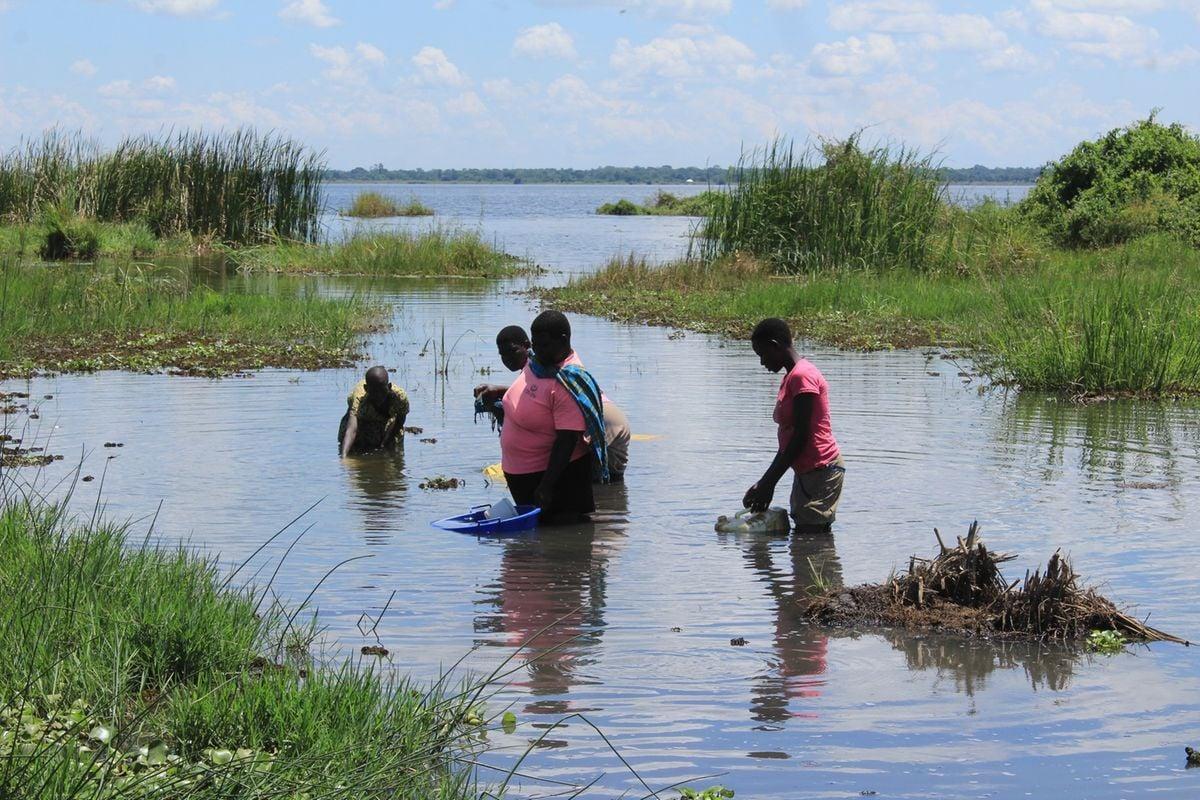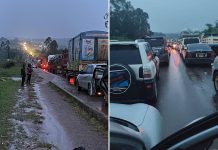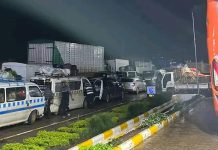Africa-Press – Uganda. Rising water levels in lakes and rivers have started swallowing up villages, sparking panic among residents neighbouring the water bodies across the country.
In the affected places, the floods have forced thousands of residents to relocate to safer places.
The floods have been triggered by the rising water levels in Lake Victoria and the heavy rain pounding the area since early March.
In the central district of Kayunga, nearly 100 households in two villages in Galilaaya Sub-county, are stranded after flash floods from Lake Kyoga submerged roads and other social infrastructure in the area.
Mr Jamada Kakinda, the Galilaaya Sub-county chairperson, said the flood water from Lake Kyoga, has so far submerged the Kitwe-Kawongo and Kawongo-Kalenge roads, and the Ntimba Primary School playground.
The two cut-off villages consisting mainly of fishermen have a population of about 800 residents.
The sub-county chairperson says food crops such as maize, potatoes, and the only borehole at Ntimba Primary School, which is the only source of clean water for Kawongo Trading Centre, has also been submerged.
Flash floods have also caused havoc in neighbouring Kalangala Islands, leaving about 1,000 households homeless. The floods have cut off three landing sites, separating them from the main Bugala Island.
The affected landing sites are Kaazi-Malanga, Mukalanga and Kasamba in Bujumba Sub-county.
Access to the three landing sites from Bugala Island has been by road, but currently, residents have to use boats to connect to the area.
At Kachanga Landing Site, more than 500 households abandoned their homes to higher grounds after their houses collapsed and business premises were submerged in water.
At Misonzi Landing Site in Bufumira Sub-county, more than 20 grass-thatched mud houses collapsed and more than 500 acres of crops were destroyed.
Mr Yasin Kalenzo, a resident at the same landing site, said he lost his seven-acre cassava plantation.
According to Mr Robert Kigozi, the Kalangala Town Council speaker, the Lutoboka- Kalangala road that connects to major beaches and ship docking areas is currently impassable.
At Bugoma Pier, where MV Pearl and MV Ssese ferries connect to Bukakkata on the mainland dock, travellers have to walk barefoot due to high water levels, to board the ferries.
Mr Joseph Byaruhanga, the senior environmental officer for Kalangala District, says the lake’s water levels in the area are currently estimated to have increased to 14 metres compared to slightly above 13 metres in 2020.
In the Entebbe Peninsula, which hosts Uganda’s international airport, about 200 houses on the lakeshores have been inundated by floodwaters, particularly in Lugonjo Village, which lies close to the Namiiro swamp, a buffer zone for Lake Victoria.
The rising water levels have not spared the Kigungu Catholic Church, a monumental structure erected in remembrance of the first two French missionaries Simeon Lourdel Pere (Mapeera) and Amans Delmas (Amansi). To access the church last Sunday, Christians had to step on logs and pieces of timber.
Mr Matia Kiggundu, a Catholic in the area, said by the time the church was constructed, the water levels were about 300 meters away and never anticipated that it would one day get submerged.
“We just pray that the structure remains standing because of its significance as a distinctive spiritual and tourist site,” he said.
Mr Richard Ssenyondo, the chairperson of Entebbe Division B, acknowledged the severity of the flooding and the potential for further escalation.
“We are not seated as local leaders. We are working closely with government and other partners to address the impact of rising waters,” he said
Dr Michael Kizza, the deputy executive director of Nile Basin Initiative, when contacted for a comment on the rising water levels, referred us to the Ministry of Water and Environment.
“The Ministry of Water and Environment monitors the lake levels, please reach out to them for a comment,” he said.
Lake Kwania flooding
More than 15,000 families in Dokolo District are currently living in dire conditions after severe flooding triggered by rising water levels on Lake Kwania left a trail of devastation.
According to residents, the most recent flooding started at the end of April when water levels on Lake Kwania started rising rapidly.
The disaster has so far displaced thousands of people, and destroyed farmlands and critical infrastructure.
Official statistics from the district show that a total of 15,152 households are affected, and are living in dire conditions in Agwata Town Council and Kwera, Adeknino, Agwata, Okwongodul, and Adok sub-counties.
Local leaders and residents said the disaster has affected access to social services such as markets, schools, and health centres, and impacted livelihoods.
Dr Rosemary Alwoc Ogwal, a resident of Adok Sub-county, said the situation has been ongoing for a long time but it is now getting to a crisis point.
“We now need to consult stakeholders about medium and long-term solutions that alleviate decades of inhuman conditions caused by floods,” she said.
According to Mr Fredrick Ogwal Owiny, the Adeknino Sub-county chairperson, 17 out of the 42 villages in his sub-county have been affected by floods. He said the severe flooding has affected pupils’ access to Abalang Primary School, while families with sick relatives cannot access Awelo Health Centre III because roads are now impassable.
Mr Ogwal Owiny said some of the displaced people are living in rented houses, while others are staying with relatives in Awelo, Tecwao and Alik trading centres, all in Adeknino Sub-county.
Adeknino has a population of about 40,000 people, according to the sub-county leadership.
In Ntoroko District, since October 2019, several villages in the Kanara Sub-county have been submerged due to rising water levels from Lake Albert.
As a result, numerous infrastructures such as roads, schools, and markets have been destroyed.
For instance, Umoja Primary School remains inundated, necessitating the relocation of the school, and by the close of the term, pupils were studying in tents.
Other primary schools such such Kachwakum, Rwangara, and Masaka were affected but later reopened.
Ntoroko District chairperson William Kasoro said the government promised in 2021 to purchase land for the displaced individuals but to date, no action has been taken.
The impact of the floods has rendered most roads impassable, particularly the road from Buntugama to Kamara.
Mr Kasoro emphasised the need for affirmative action from the government, given the district’s remote location and the extensive damage caused by the floods.
“Some of the displaced people are still staying in temporary camps established by locals, with the locals renting out the land,” he said.
However, in villages where water levels have receded, people have begun returning.
Rwangara Health Centre III, which was submerged in 2019, has been reconstructed by the government through the Office of the Prime Minister at a cost of Shs800 million.
The health facility was commissioned last month, enabling residents of the Kanara Sub-county to access healthcare services once again..
What experts say
In 2020, the Ministry of Water and Environment revealed that the water level on the lake had risen to 13.32 metres. However, Mr Joseph Byaruhaga, the Kalangala District senior environmental officer, says the water level has now reached 14 metres.
Experts say the current rainy season has doubled volumes of water in rivers, which flow into Lake Victoria.
“Water will always flow in the same direction so whoever constructed in the water path should vacate or else they will lose their property in floods,” Ms Naome Karekaho, the National Environmental Management Authority (Nema) spokesperson, says.
She says encroachers on river banks and lake shores should prepare for the worst if they don’t vacate now.
“Lake Victoria usually gets 80 percent of its water from direct rainfall that contributes heavily to the increase in the volumes of water,” Ms Karekaho explains.
Environmentalists blame the floods on climate change occasioned by global warming caused by the destruction of the environment.
Source: Monitor
For More News And Analysis About Uganda Follow Africa-Press






